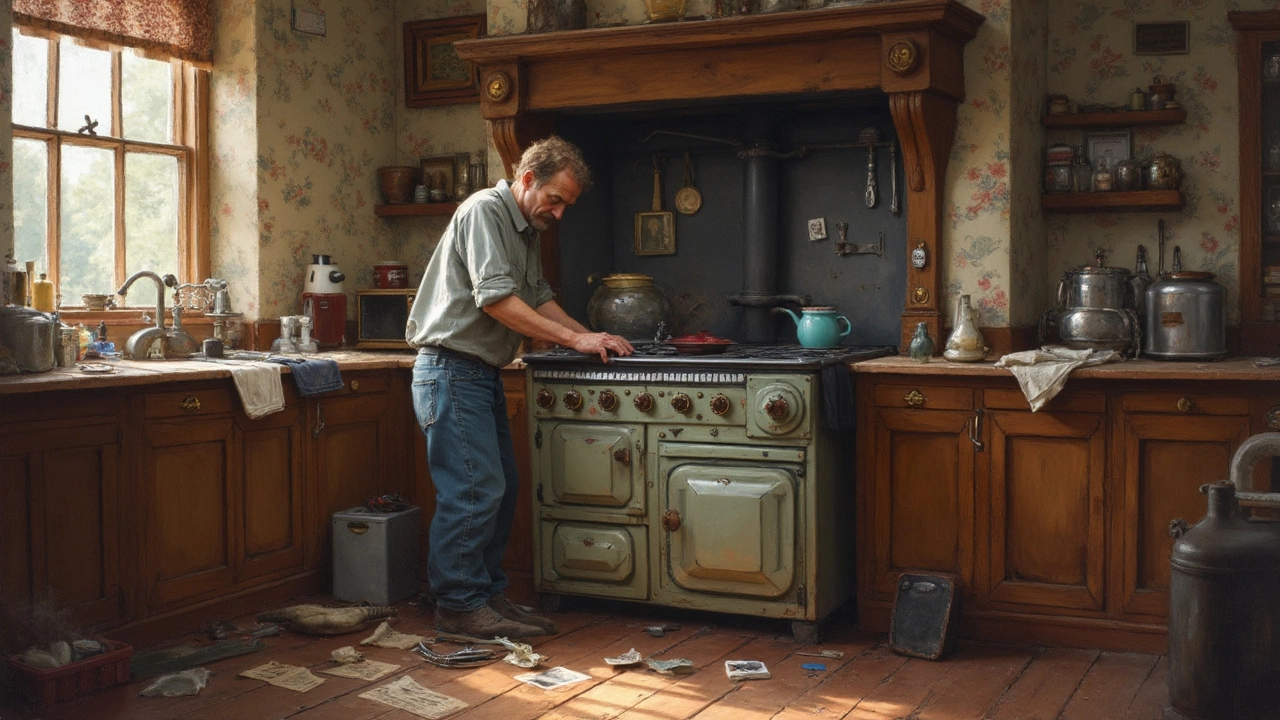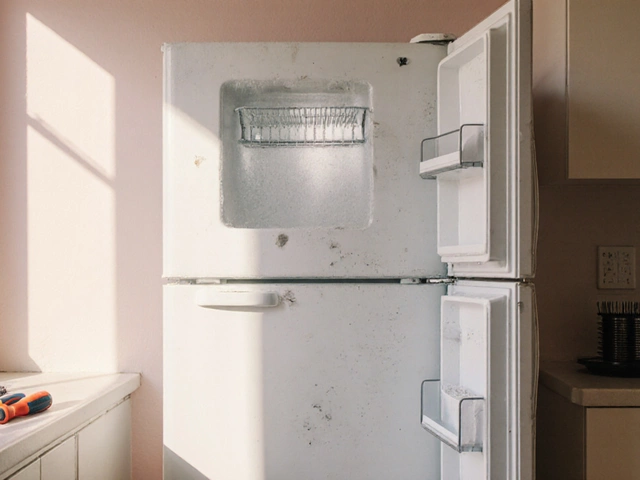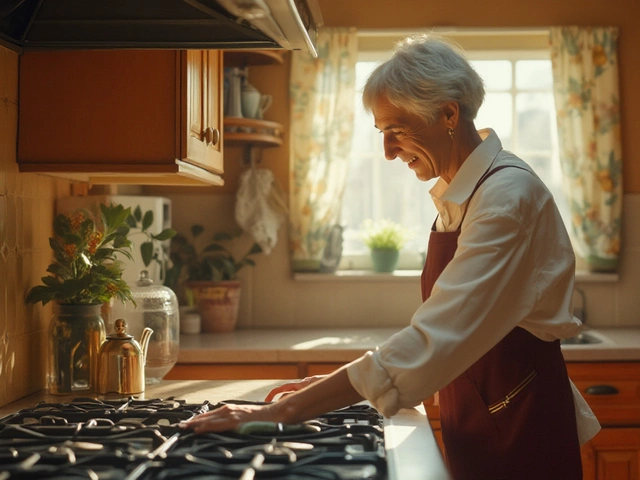You've got dinner planned and boom — your cooker decides to fail you. It's a frustrating experience, right? You're probably wondering if you can fix it yourself or if you need to call a professional. Let's break it down.
Cookers have a lot of moving parts, and things can go south fast. Whether it's the hob that won't heat or an oven door that won't close, these issues seem tricky but are often fixable without too much hassle. Many problems come from wear and tear, which means with a bit of elbow grease and the right guidance, you might just save the day.
DIY repairs can be your best friend, but they need some basic know-how. We'll help you figure out when to do it yourself or when it's best to throw in the towel and call an expert. Stay tuned as we jump into common issues and easy solutions to tackle them.
- Common Cooker Problems
- DIY Repair Tips
- When to Call a Professional
- Cost of Repairs
- Preventative Maintenance
Common Cooker Problems
If you've owned a cooker for any length of time, you'll know they aren't without their quirks. Let’s dive into some issues that tend to pop up more often than we'd like. Understanding these can help you keep your appliance in shipshape.
Heating Issues
The most common complaint? The cooker isn't heating properly. If your cooker won't heat, it could be an issue with the heating element. For electric cooker repair, this usually involves checking the element for any visible damage or using a multimeter to test its continuity. Gas appliances might have clogged burners — a fixable issue that often just requires a good clean.
Oven Door Problems
Another common gripe is when the oven door refuses to shut tight. Warped hinges or door seals often cause this. While bent hinges usually need replacement, gaskets or seals might just need realignment. Ensuring your oven door closes properly helps maintain the heat balance, making sure your food cooks evenly.
Burner Ignition Issues
If gas burners are taking ages to ignite or won't ignite at all, this can be due to a faulty ignition switch or pilot light issues. Dirt and debris build-up could be to blame. Regular cleaning can often alleviate this problem, and sometimes, swapping out worn-out ignition components is necessary.
Broken Knobs and Controls
Knobs that don't turn or respond? That's a classic. Either they're just loose, or the knob's inner parts have worn down. Don’t fret, though; replacing these parts is usually pretty straightforward and inexpensive. Just remove the old one and pop on a new one.
These issues are just a few examples of what you might encounter, but they cover a good chunk of the usual suspects. Knowing how to identify and deal with these problems doesn't just save you a service call; it keeps you in control of your kitchen adventures.
DIY Repair Tips
Rolling up your sleeves to tackle cooker repair might seem intimidating, but often it's not as challenging as it looks. Many common cooker woes can be fixed without needing to get a pro involved. Let's go through some hands-on tips.
Check the Power Supply
First things first, make sure your cooker is actually plugged in and getting power. This might sound obvious, but you'd be surprised how often a loose plug is the culprit. Double-check the outlet with another appliance to be sure it's working.
Thermostat Troubles
If your cooker isn't heating properly, the thermostat might be the issue. To test it, use a multimeter to check for continuity. If it's faulty, you'll need to replace it, which is usually a straightforward swap.
Replacing Oven Elements
An oven that won't heat is often due to a blown element. Turn off the cooker at the mains, and take a look inside. If you can see visible burns or cracks, it's time for a replacement. You can find the right parts at an appliance store or online.
- Turn off the power.
- Remove the faulty element by unscrewing it.
- Attach the new element and screw it in place.
- Turn the power back on and test.
Dealing with Gas Hobs
Got a gas cooker? If the flame isn't coming on, the igniter could be dirty. Carefully clean it with a toothbrush and ensure it's not blocked. Be cautious and make sure you turn off the gas supply before cleaning.
Knobs and Dials
Loose or broken knobs are a common irritant. Sometimes, all it takes is tightening or replacing them. Most knobs simply pull off, making it easy to swap them with new ones.
Appliance fix doesn't always have to mean a full overhaul. Often, it's these small tweaks that get things working again. Just remember, when in doubt, consult your cooker manual or seek guidance from someone with kitchen maintenance experience.

When to Call a Professional
Sometimes, your trusty DIY approach isn't enough to handle a stubborn cooker problem. Knowing when to raise the white flag and call a pro can save you a lot of hassle, and potentially prevent further damage. Here are some situations where seeking a professional's expertise is a smart move.
Complex Electrical Issues
When it comes to electrical glitches, it's best not to mess around. If your cooker is experiencing appliance fix problems like irregular power supply or mysterious circuit breaker trips, an electrician might be your lifeline. Messing with wiring not only risks the appliance, but also your safety. According to the National Fire Protection Association, faulty wiring causes thousands of fires annually. So, better leave it to someone who knows the ins and outs.
Gas Leaks
A faint gas smell or a hissing sound? Stop right there. These signs scream for professional intervention. Gas issues are not just about fixing the kitchen maintenance side of things; they're severe safety hazards. Professionals have the tools to detect leaks and fix them before they escalate.
Internal Parts Replacement
For parts hidden deep within the cooker, calling a professional ensures the job's done right. Whether it’s a broken thermostat or malfunctioning heating elements, experts have the necessary skills and parts. They can install them correctly, avoiding any damage to your cooker in the process.
Warranty and Insurance Concerns
If your cooker is still under warranty, it’s worth noting that DIY tinkering might void it. Also, some home or appliance insurance policies require certified repairs for claims. Check your documentation and, if necessary, reach out to a professional to keep your warranty or insurance intact.
In short, while some cooker repairs are straightforward, others require a more skilled hand. Know your limits, and don't hesitate to reach out to the pros when your cooker is acting up beyond your comfort zone.
Cost of Repairs
So, your cooker is on the fritz, and you're wondering how much this fix might burn a hole in your pocket. It's a fair concern since appliance repairs can hit anywhere from cheap to shockingly pricey. Let's break down what you might expect when fixing your trusty cooker.
Typical Repair Costs
On average, repairing a cooker can set you back between $100 and $300. The cost primarily depends on the part that's acting up and how much effort it takes to fix. A simple job like replacing a knob might just be $50, but if you've got a more complex issue like a broken thermostat, you could be looking at $250 or more.
For those curious about specific part prices, here’s a rough idea:
- Heating element: $100 - $200
- Thermostat: $150 - $300
- Knobs and switches: $20 - $75
DIY vs. Professional
Now, it might be tempting to turn this into a DIY project to cut down on costs. While swapping out a knob on your own is no big deal, messing with the electrics or gas lines is a different story. Unless you're very familiar with appliance repairs, it might be best to call in a professional. The safety margin you'll buy with expert help often outweighs the cost. For a professional, the hourly rate can range from $50 to $150, depending on your location.
Considerations
If your cooker is getting up in years, weigh the cost of repair against splurging on a new model. Sometimes frequent fixes can add up to more than the price of a new, energy-efficient cooker. Don't forget to consider the age of your appliance, and if you find you're calling out repair technicians more often, it might be time to say goodbye to the old faithful.

Preventative Maintenance
Keeping your cooker in tip-top shape can save you a lot of repair headaches down the road. Regular maintenance isn't just for the pros; there's quite a bit you can do yourself to make sure your appliance keeps running smoothly. Let's dive into the essential maintenance tasks that you should be doing.
Regular Cleaning
This might sound basic, but regular cleaning is one of the most important steps in kitchen maintenance. A clean cooker is a happy cooker, after all. Clean spills and splatters immediately to prevent them from hardening. Make it a habit to wipe down surfaces after each use with a damp cloth.
Check for Wear and Tear
Every now and then, give your cooker a once-over. Look for any cracks, frayed wires, or loose screws. These small signs can be early indicators of bigger problems. Fixing a simple issue early can often prevent costly disasters.
Inspect the Burners
Burners can get clogged, resulting in uneven cooking or no heat at all. Remove and clean burners periodically to ensure they are free of food particles. A simple soak in soapy water can do wonders.
Replacing Worn Out Parts
Some parts, like knobs or burner caps, wear out faster than you'd expect. Keep an eye on these and replace them as necessary. Replacements are often easy to find and install.
Here's a quick tip: Keep a spare set of knobs at home. They are inexpensive and can be lifesavers if any break or get damaged.
Professional Servicing
Even with all your efforts, it's a good idea to have a professional check your cooker once a year. They can spot and fix potential issues you might miss.
| Task | Frequency |
|---|---|
| Clean surfaces | After every use |
| Inspect for wear | Monthly |
| Clean burners | Every 3 months |
| Professional servicing | Yearly |
By following these preventative maintenance tips, you ensure your cooker stays in great shape, saving you from unexpected breakdowns and costly repairs. Plus, you keep your kitchen maintenance game strong. Remember, a little attention now means fewer headaches later.





